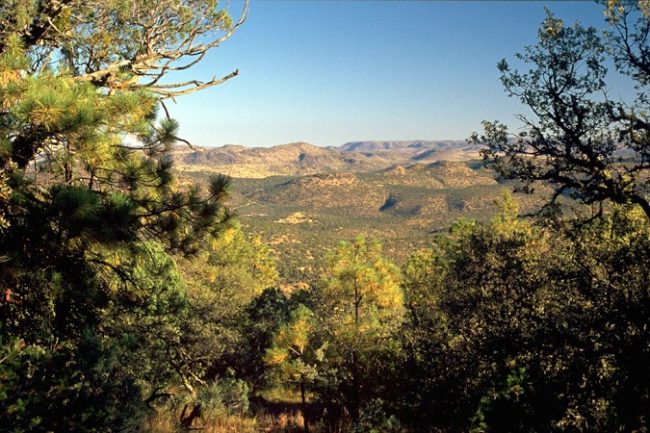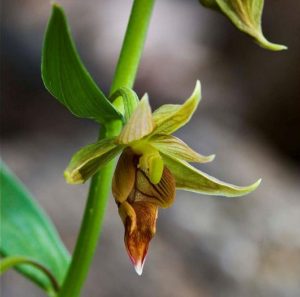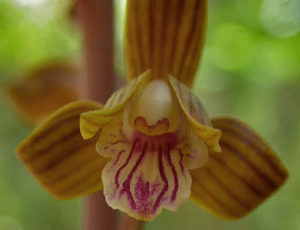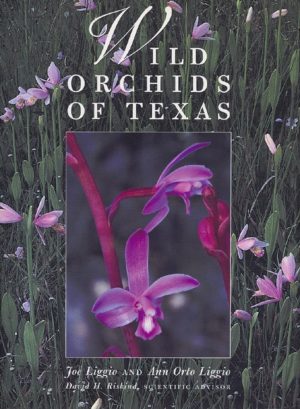
Landowners are motivated to work with conservation groups with help of tax laws
In 1976, tax laws were written to allow landowners to begin reporting the value of an easement on their land as a tax deduction. This change in the tax laws resulted in a significant increase in landowners making properties available to various conservation organizations under easement agreements. Additional laws were later passed, raising the limits on the amount landowners can deduct from income taxes, thereby accelerating the use of easements. These Enhanced Easement incentives expire Dec 31, 2014 and the bill to make the enhanced incentives permanent failed to pass in the 113th congress. Unless the new congress acts, it is back to the normal non-cash donation rule limits in 2015.

“Chatterbox Orchid” Epipactis gigantea
What a surprise to learn that our legislators actually came up with something so useful! I first learned about easements and their related tax laws as I was thumbing through the November 2014 issue of Nature Conservancy Magazine. I wondered why an article about easements would be in a publication by The Nature Conservancy, and having never properly understood this concept, I decided to read on. I learned that by using what are called “conservation easements” this fine organization is able to protect tracts of land from development, thereby saving the habitats of untold numbers of plant and animal species.
Here is how this works:
A conservation easement is a binding agreement between a private landowner and the easement holder to preserve a property’s “natural value”. The landowner gets tax benefits or payment for giving up development or other land-use rights. The easement holder is responsible for enforcing the agreement’s conditions. Even in a case where the property changes hands, the restrictions remain in place.
The Nature Conservancy is the largest non-profit easement holder in the United States. They protect 3.9 million acres as easements granted directly to the Conservancy as of March 2014. This is part of the 20 million total acres the Conservancy protects, purchased outright and through easements. Historically, since 1954, the cost for an outright purchase of an acre of land for protection has shown to be about 5 times more than the cost of purchasing easements on an acre. Clearly, taking advantage of easement laws is an extremely cost effective method of increasing acreage to be put under protection. As of this writing, The Nature Conservancy holds 2,475 easements with an average size of 1,250 acres.
A Nature Conservancy easement success close to home – in West Texas — is the Davis Mountains Reserve (see photo at top). With help from the Conservancy, this reserve was expanded by over 33 thousand acres and conserves almost 70 thousand acres of privately owned land with 20 easements. All told, the Conservancy has a total of 131 easements in Texas, covering almost 350 thousand acres.

Hexalectris spicata orchid – species native to Texas
The Davis Mountains Reserve reserve is particularly relevant to orchid lovers, as shown in the book “Texas Wildflowers” by Campbell and Lynn Louchmiller (1984). The great coral root orchid, Hexalectris grandiflora, can been found in the Davis and Chisos mountains near oak and madrone trees. This species is myco-heterotrophic, meaning it lacks chlorophyll. Its proximity to trees suggests that it subsists entirely on nutrients obtained from fungi in the soil. Other Hexalectris orchid species exist in our Great Trinity Forest south of Dallas under similar growing conditions.
We have in the United States alone, nearly 650 million acres of federally protected lands as National Parks and Wildlife Refuges. State and local land trusts, government agencies, and national conservation groups protect an additional 40 million  acres through easements, most having been secured in the last few decades. Easements are an important and significant portion of our protected land. It is by the use of easements that organizations such as The Nature Conservancy are able to protect much more land than they could if they were to make an outright purchase.
acres through easements, most having been secured in the last few decades. Easements are an important and significant portion of our protected land. It is by the use of easements that organizations such as The Nature Conservancy are able to protect much more land than they could if they were to make an outright purchase.
We all can enjoy the good feeling we get when we support a cause we care about, particularly if by doing so we protect some valuable natural habitats for future generations to enjoy. With 4,000 acres a day of open spaces being lost to development in this country, our support is crucial. Put The Nature Conservancy somewhere in your support in 2015 and chances are some of our country’s wild orchids will be given a secure future.